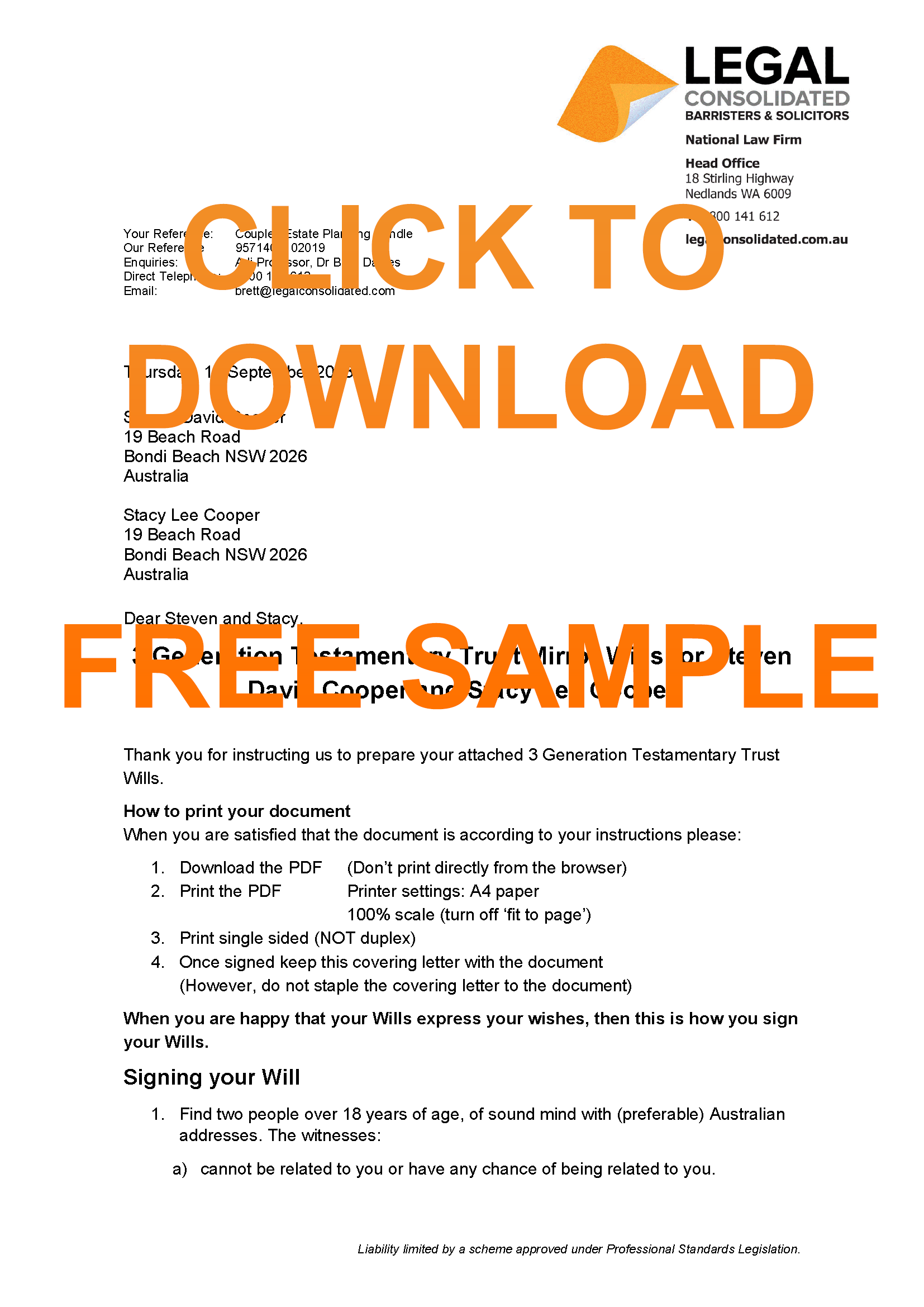
Independent Contractor Agreement
$448 includes GST
-
Works throughout Australia. Update via an exchange of emails.
Independent Contractor Agreement
The principal has a business. The contractor has a different business. The principal requests and pays for services. The person providing the services is the contractor.
The contractor is ‘independent’. The contractor is not an employee.
Employee vs Independent Contractor Agreement
Employees have rights. An employer provides annual leave, sick leave, long service leave and superannuation. An employer tells the employee when and where to go to work. The employer provides control and direction.
In contrast, Australian independent contractors operate their own businesses. Contractors set their own fees and working conditions.
However, the difference between an employee and a contractor can blur.
The difference between an employee and a contractor?
The Independent Contractor Agreement you are building helps prove that the contractor is a contractor and not an employee. However, an Independent Contractors Agreement is not conclusive. Just because you say a person is a contractor that may not be enough.
Many different things decide whether you are dealing with someone as a contractor or as an employee:
| Common for Employee | Common for Contractor |
|---|---|
| Directed and supervised | In control and may delegate work to another person |
| Works 9-5 | Works to complete the task |
| May work for you for many years | Performs the contract or a specific task eg. deliver 30,000 widgets |
| Employment Contract | Independent Contractor Agreement or Service Trust Agreement |
| No risk of capital or financial risk | Makes a profit out of dealing with the principal, won’t get paid if Contractor fails to perform |
An Independent Contractor Agreement is a ‘contract for services’.
The Principal requests and pays for the services. The person providing the services is the Contractor.
- The Principal operates a business.
- The Contractor operates a different business.
A contract for services is not an employment relationship. The Contractor is ‘independent’ as the Contractor is not an employee of the Principal.
Employees are different from contractors
Employees have guaranteed employment rights. These include paid annual leave, sick leave, long service leave and superannuation contributions.
An employer has more control over an employee. An employer directs when the employee comes to work and the location of the work. There is a great deal of control and direction by an employer.
In contrast, Independent Contractors operate their own business. Contractors set their own fees and working conditions. Contractors may take work from other clients.
However, the difference between an employee and a contractor can blur.
Is a Contractors Agreement conclusive that there is no employee relationship?
The Independent Contractor Agreement that you are building helps prove that the Contractor is a contractor and not an employee.
However, an Independent Contractor Agreement, in itself, is not conclusive. Just because you say a person is a Contractor that may not be enough.
The Australian courts state that even a clear and unambiguous Contractors Agreement is not determinative of the relationship. Rather, the courts look at the totality of the relationship between the parties when determining the substance and the reality of the relationship.
See, for example, Jamsek v ZG Operations Australia Pty Ltd (2020). The Federal Court of Australia found that two truck drivers working nearly 40 years as independent contractors for the same business were employees. This is when the totality of their relationship with the business was examined.
How do I know I have a contractor and not an employee?
Many different things decide whether you are dealing with someone as a contractor or as an employee:
1. An employee is directed and supervised. A contractor is in control and may delegate work to another person.
2. An employee works, say ‘9 to 5’. A contractor works to complete the agreed task.
3. An employee may work for you for many years. A contractor performs the contract or a specific task. For example:
- Make 30,000 nuts and bolts to the specifications required.
- Clean the doctor’s surgery toilets.
4. The employee has no risk of capital or financial risk. The contractor makes a profit out of dealing with the principal. The contractor may not get paid if the contractor fails to perform. E.g. the contractor spends two weeks making 30,000 nuts and bolts, if they are faulty the contractor does not get paid.
Factors that suggest you have a Contractor
Factors that suggest a Contractor (rather than an Employee) include:
- Contractors Agreement (not an Employment Contract)
- low level of control by the Principal
- no minimum wage entitlements or other entitlements
- no requirement for workers compensation
- no unfair dismissal or unlawful termination claim rights
- the potential to substitute labour or delegate work
- freedom for the Contractor to work for other clients
- Contractor provides their own tools and equipment
- The contractor provides his own insurance
- Contractor registers and uses an Australian Business Number (ABN)
- The contractor files business tax returns and makes deductions
- expressly describing the arrangement as a ‘contract for service’
- Contractor provides Tax Invoices
Principal may still need to pay super and have workers’ compensation
- superannuation payments
- PSI tax
- PAYG tax withholding
- workers compensation
- Occupational Health and Safety
These requirements do not in themselves make an Independent Contractor an Employee. You may have these entitlements but it does not make the genuine Independent Contractors relationship one of Employment.
- Vabu v Federal Commissioner of Taxation (1996) 81 IR 50
- Hollis v Vabu (2001) 207 CLR 21
- On Call Interpreters and Translators Agency Pty Ltd v Commissioner of Taxation (No.3) (2011) FCA 366
How to pay a Contractor
The Principal pays the Contractor in one of three ways:
1. As agreed by both parties from time to time (common for a Service Trust Agreement)
If you select ‘as agreed by the parties from time to time’, then you agree to the payment from time to time. This is via an exchange of emails. This is particularly common for service trusts.
For example:
- The email you send to the Contractor is: For the next 12 months, the Principal gives you $110 for each widget you supply to the Principal’.
- Share of the revenue. Here you may give the contractor, say 20% of the revenue from the sale you make of each item the contractor produces. The email you send to the Contractor, this year, would be: ‘Until the Principal decides otherwise, the Principal gives you 20% of the revenue earned on the sale of the widget for each widget provided to the Principal and sold by the Principal‘.
2. The Principal pays the Contractor a ‘One-off Payment’
The Principal agrees to pay the Contractor a one-time fee. This is for the work the Contractor performs. Also called a ‘lump sum’ payment or ‘by the job’.
Here the Principal pays for the work done or by the job.
For example:
- The Bricklayer (Contractor) builds the entire wall before the Landowner (Principal) pays him.
- The financial adviser (Contractor) completes 200 files before the financial planning practice (Principal) pays him.
- A blogger (Contractor) gets paid by the number of blog posts created for the Principal.
- A cleaning service (Contractor) gets paid a set amount for each time the Principal’s office is cleaned.
3. Principal pays the Contractor an Hourly-Rate
The Principal agrees to pay the Principal a pre-determined amount. For example, $145 per hour. This is for each hour the Contractor performs work for the principal. For example:
- The Electrician (Contractor) charges for each hour he takes wiring up lights at the Landowner’s (Principal) property.
- The accountant (Contractor) consultant charges the accounting house (Principal) $110 per hour to work for the accounting house.
If the Contractor is registered for GST, then the hourly rate includes GST.
Uber vs Contractor vs Employee
The UK Supreme Court upheld that two Uber drivers are employees of Uber. This is rather than self-employed independent contractors. The ruling gives the ’employees’ additional statutory entitlements. These include, in the UK, the minimum national wage, annual leave, other benefits and protections.
UK Uber and contractors
In 2016, the UK Employment Tribunal found that two Uber drivers are employees. They are part of Uber’s business. They are not self-employed independent contractors. Uber lost each appeal in the UK’s lower courts.
Sadly, in 2021 the UK Supreme Court upheld the Tribunal’s decision. The drivers are employees.
- The Uber drivers are, apparently, in a ‘position of subordination and dependency to Uber’.
- Uber had a substantial degree of control over the drivers.
- The drivers had minimal or no ability to increase their earnings other than by working longer hours.
The above provided an employment relationship.
The UK Supreme Court looked at the legal relationship between the drivers and Uber.
We have different laws in Australia. And our Courts are not so left-wing and controlled by Unions. Still, we have distilled the case to 5 reasons that the Uber contractors are now employees:
- Uber controlled the fare. This supposedly set what the drivers could earn.
- Drivers did not have a say in the Uber contract.
- Uber punished drivers who rejected too many rides. Drivers’ requests for rides are governed by Uber.
- Uber may end the relationship with the driver. This is if the driver:
- did not maintain a required average rating; and
- failed to improve or maintain the rating.
- Uber restricted talking between passengers and drivers.
The UK Court is clearly wrong. Consider that the drivers:
- supplied their own equipment
- were not permitted to represent Uber in any way
- were registered for the equivalent of GST
- had the freedom to log on and log off the Uber app at any time.
They show limited control over the Uber drivers. There is no employment relationship. The UK drivers are genuine contractors.
Australia does not follow the left-wing UK position on contractors
Thankfully in 2017 (Kaseris v Rasier Pacific) 2019 (Gupta v Uber Australia Pty Ltd t/a Uber Eats) the Fair Work Commission held that Uber drivers were contractors. This was for some cheeky Uber drivers trying to argue an unfair dismissal.
However, if Australia were to go down the UK approach then many powerful groups like Woolworths, Coles and the big mining companies would end up being deemed to be employing many of its contractors. As such organisations have an unfair bargaining position when they deal with their contractors and farming groups.
Does the Independent Contractor Agreement include a Confidentiality clause?
Yes. There are extensive confidential clauses in the Legal Consolidated Independent Contractor Agreement. This protects the principal. (Have a look at the above full free sample of the ICA.) The confidentiality clauses are automatically put into the ICA.
The general obligations to be confidential, loyal and act in the principal’s best interest are in the Independent Contractor Agreement.
You can build a stand-alone confidential agreement on Legal Consolidated’s website. But, you do not need a separate confidential agreement if you have a Legal Consolidated Contractor Agreement. This is because the confidentiality clauses are automatically included in all Legal Consolidated ICAs.
(The position is the same for Legal Consolidated Employment Contracts.)
Updating the Independent Contractors Agreement from time to time
The ICA allows you to refer to other documents. This is by an exchange of emails. The other documents could include the scope of work, plans, diagrams and specifications.
Amend the Independent Contractor Agreement by an exchange of emails at any time.
Service Trust vs Independent Contractors Agreement
All service trusts are a type of Independent Contractors Agreement. However, not all ICAs are services trusts.
A doctor, accountant, lawyer, engineer and other professional partnerships often use a ‘service trust’. These are usually a Unit Trust, company or Family Trust. You need an Independent Contractor Agreement (Service Trust Agreement) to make this work.
Business Structures
Family trust
- Family Trust Deed – watch the free training course
- Family Trust Updates:
- Everything – Appointor, Trustee & Deed Update
- Deed ONLY – only update the Deed for tax
- Guardian and Appointor – only update the Guardian & Appointor
- Change the Trustee – change human Trustees and Company Trustees
- The company as Trustee of Family Trust – only for assets protection?
- Bucket Company for Family Trust – tax advantages of a corporate beneficiary
Unit trust
- Unit Trust
- Unit Trust Vesting Deed – wind up your Unit Trust
- Change Unit Trust Trustee – replace the trustee of your Unit Trust
- Company as Trustee of Unit Trust – how to build a company designed to be a trustee of a Unit Trust
Corporate structures
- Partnership Agreement – but what about joint liability?
- Incorporate an Australian Company – best practice with the Constitution
- Upgrade the old Company Constitution – this is why
- Replace lost Company Constitution – about to get an ATO Audit?
- Independent Contractor Agreement – make sure the person is NOT an employee
- Service Trust Agreement – operate a second business to move income and wealth
- Law firm Service Trust Agreement – how a law firm runs the backend of its practice
- Medical Doctor Service Trust Agreement – complies with all State rules, including New South Wales
- Dentist Service Trust Agreement – how dentists move income to their family
- Engineering Service Trust Agreement – commonly engineers set up the wrong structure
- Accountants Service Trust Agreement – complies with ATO’s new view on the Phillips case

